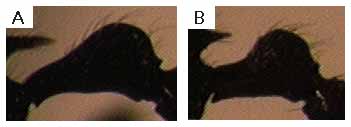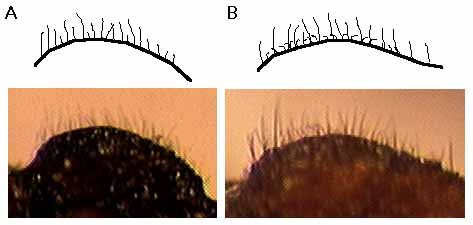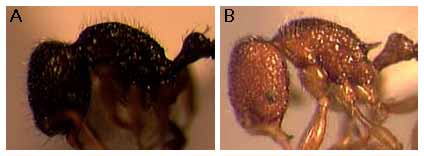
| Genus List | Species List |
This key is adapted from Kugler (1994).
10a. AT4 (first tergum of gaster) with no erect setae, or at most a row at the posterior border; AT4 pubescence short, sparse, and completely appressed; erect setae absent or very inconspicuous on face and mesosoma: 15
10b. At least some conspicuous pilosity, either erect setae on dorsum, or suberect pubescence, or both: 20

15a. Mesosomal dorsum completely lacking erect setae; pubescence of mesosomal dorsum completely appressed: foreli
15b. Mesosomal dorsum with at least a pair of setae on humeri (although often very fine and difficult to see); pubescence of mesosomal dorsum often slightly raised: cuneola

20a. Very dense, flexuous, erect hairs on dorsa of head, mesosoma and gaster; no decumbent or appressed pilosity; promesonotum uniformly and densely areolate: 50
20b. Erect hair not so dense or flexuous; decumbent hair usually present; promesonotum may have some rugae or carinae: 100

50a Metanotum forms an abrupt declivity between promesonotum and propodeum: gibba
50b. Shallow metanotal groove hardly interrupts mesosoma profile: blanda

100a. Sparse, stiff, erect-suberect hairs and short appressed hairs on dorsa of head, mesosoma, waist, and gaster; WL greater than 0.72mm; eye with more than 25 facets: terescandens
100b. Erect hairs more curved and tapered; shorter pilosity, if present, usually decumbent; if some erect hairs are stiff, then WL and eye are smaller: 150

150a. Petiole clavate; eye with 39-48 facets: tonduzi
150b. Petiole with a distinct node and/or smaller eyes: 200

200a. Undamaged hair on mesosoma dorsum mostly erect to suberect; decumbent hairs, if present, much less abundant than longer, more erect pilosity: 220
200b. Mesosoma dorsum with appressed or decumbent pilosity, usually in addition to longer erect to suberect hair: 300

220a. Propodeal spines reduced to short tubercles: inermis
220b. Propodeal spines distinct, spiniform: 260

260a. Size relatively smaller (WL less than 1mm); propodeal spines relatively shorter (spine length, measured from edge of propodeal spiracle to tip of spine, less than or equal to 0.20mm): belti
260b. Size relatively larger (WL 1.30mm, n=1); propodeal spines long and stout (spine length 0.35mm): cornuta

300a. Scapes with longer erect to suberect hair in addition to shorter decumbent to appressed pilosity: 310
300b. No erect hair on scapes: 400

310a. Face and mesosoma punctatorugose, rugae feeble; pilosity sparse, decumbent pilosity most evident on mesosoma, but very weak on gaster; WL 0.70mm (n=1): JTL-001
310b. Face and mesosoma coarsely rugose or areolate rugose, interspaces smooth or feebly punctate; pilosity abundant on mesosoma and gaster, with both erect and decumbent pilosity conspicuous; WL 0.54-0.93mm: 320

320a. WL 0.54-0.66mm; petiolar node relatively more symmetric: leptonana
320b. WL 0.63-0.93mm; petiolar node somewhat skewed anteriorly, with anterior slope somewhat shorter and steeper than posterior slope: creightoni

400a. Setae on gaster differentiated into two distinct kinds, short decumbent and long erect: innotabilis
400b. Setae on gaster not differentiated into two distinct kinds: neilyensis

Literature Cited
Kugler, C. 1994. Revision of the ant genus Rogeria (Hymenoptera: Formicidae) with descriptions of the sting apparatus. Journal of Hymenoptera Research 3:17-89.
Page authors:
John T. Longino, The Evergreen State College, Olympia WA 98505 USA.longinoj@evergreen.edu
Grant Ramsey, The Evergreen State College, Olympia WA 98505 USA.
Charles Kugler, Radford University, Radford VA 24142 USA.